Models for water-sensitive middle suburban infill development (State of Australian Cities Conference presentation)
Abstract
Infill development in Australian cities over the coming decades is expected to have considerable negative influence on the hydrology, resource efficiency, liveability and amenity of our cities. This project aims to develop and apply a performance evaluation framework to understand infill impacts, create design options and processes for improved outcomes through case studies, and identify improved governance options and arrangements.
A 'typologies catalogue' of spatial configurations and architectural models relevant to high amenity medium density infill development has been prepared, with different arrangements and combinations of buildings and open spaces applied on a case study development site in Adelaide, SA. Design scenarios from the catalogue are evaluated against a range of qualitative and quantitative performative criteria, developed in consultation with industry partners, including water and thermal comfort performance assessment. The case study site designs offer practical models and methods for achieving infill development and densification in a manner that improves amenity within the dwelling, across the site and for the surrounding precinct – while maintaining or improving hydrological performance and thermal comfort. During this process, a set of key design principles for water sensitive infill development is defined, with prospects to further inform infill development practice and related policies.
